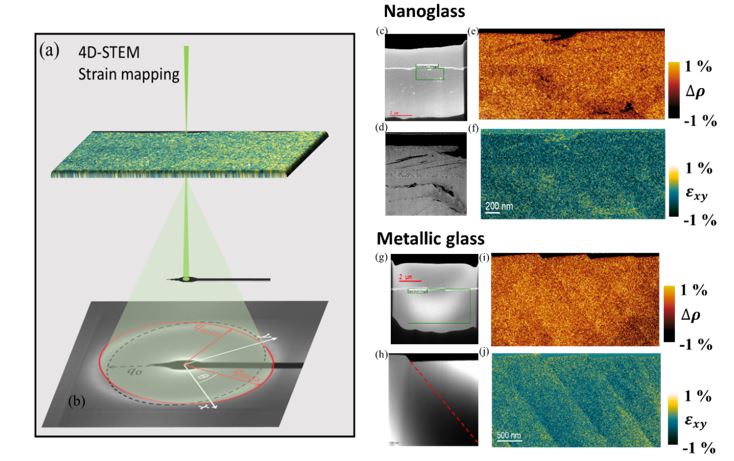Video Article Open Access
Homogeneous Plastic Deformation of Pd-Si Nanoglass under Tribological Deformation
Sangjun Kang1,2,*, Arnaud Caron4, Yulia Ivanisenko1, Sree Harsha Nandam1, Herbert Gleiter1, Christian Kübel1,2,3, Xiaoke Mu1
1Institute of Nanotechnology, Karlsruhe Institute of Technology, 76344 Eggenstein-Leopoldshafen, Germany
2Joint Research Laboratory Nanomaterials, Technical University of Darmstadt (TUDa), 64287 Darmstadt, Germany
3Karlsruhe Nano Micro Facility (KNMF), Karlsruhe Institute of Technology (KIT), 76344 Eggenstein-Leopoldshafen, Germany
4KoreaTech, Korea University of Technology and Education, Chungnam Province 330-708, Republic of Korea
Vid. Proc. Adv. Mater., Volume 3, Article ID 2208345 (2022)
DOI: 10.5185/vpoam.2022.08345
Publication Date (Web): 23 Nov 2023
Copyright © IAAM
Graphical Abstract

Abstract
Nanoglass was discovered to represent a novel structural modification of conventional glassy materials by having new intrinsic structural features, e.g. planar defects or interfaces, on the nanometer-level length scale [1]. Such structural features were noted to delocalize strain and thus enhance deformability of a glassy matrix [2]. In fact, recent studies have shown that some nanoglasses deform plastically without generating shear bands and thus result in homogeneous plastic flow [3]. Therefore, nanoglasses can exhibit higher ductility and toughness compared to those of fast-quenched glasses. [4-5]. The mechanical properties of nanoglasses are interesting because these new glass-type materials can overcome the current limitations of conventional glassy materials. However, to date, the understanding of the atomic-level structure of nanoglasses and its correlation with their deformation behavior are not yet well understood, although they are likely to be crucial for developing the deformation theory of nanoglasses. In this work, a novel nanoglass, Pd-Si, was synthesized using the inert gas condensation (IGC) method and it was deformed by scratch testing. The deformed structure of the Pd-Si nanoglass was studied by correlatively imaging the strain field and the atomic packing density at the nanoscale using 4-dimensional scanning transmission electron microscopy (4D-STEM) as shown in Fig. 1. For a comparative study, the deformed structure of a Pd-Si melt-spun glass was also investigated under the same experimental condition. The results indicate isotropic residual strain fields in the deformed Pd-Si nanoglass after plastic deformation revealing the homogeneous deformation behavior at the nanoscale, whereas the Pd-Si melt-spun glassy ribbon showed localized deformation in the form of shear bands. The observations confirm that the special deformation behavior of nanoglasses is intimately linked to their intrinsic structural features.
Keywords
Nanoglass, 4D-STEM, homogeneous deformation, strain mapping, shear bands.
Acknowledgement
Financial support from Deutsche Forschungsgemeinschaft (DFG) for grant MU 4276/1-1.
References
- J. Jing et al., J. Non-Cryst. Sol., 1989,113, 167.
- Z.D. Sha et al., Nanoscale., 2015, 7, 17404-17409.
- Y. Ivanisenko et al., Adv. Eng. Mater., 2018, 20, 1800404.
- S. H. Nandam et al., Acta Mater., 2017, 136, 181.
- N. Chen et al., Acta Mater., 2011, 59, 6433.
Video Proceedings of Advanced Materials

Upcoming Congress



